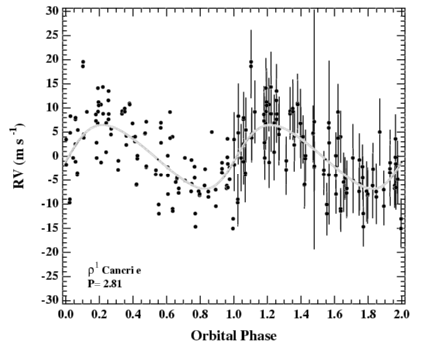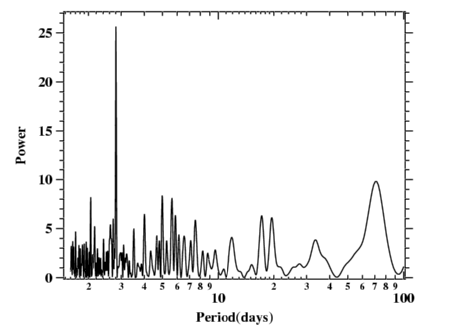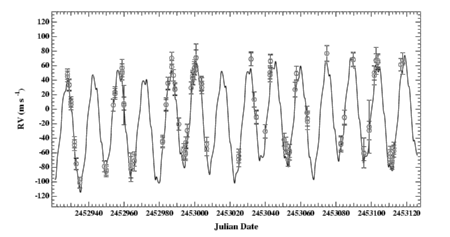Detection of a Neptune-mass planet in the rho 1 Cancri system using the Hobby-Eberly Telescope
The Discovery:
Observations of the rho 1 Cancri planetary system over the time period from October 2003 to April 2004 using the Hobby-Eberly Telescope
(HET) at McDonald Observatory led to the
discovery of a new and extremely low-mass extrasolar planet.
A low amplitude signal with a period of 2.8 days is revealed in our radial velocity
(RV) measurements after the subtraction of the already known three planets (Butler et al. 1997, Marcy et al. 2002) in this system.
The semi amplitude of the RV signal is only 6.7 m/s which translates into an m sin i of only 14.2 Earth masses!
The false-alarm-probability (a measure of the statistical significance) of this signal is very low: 1 in 1.7 billions.
This new planet makes the rho 1 Cnc system a very unique system: it is the first extrasolar planetary system with four
known planets and represents a very interesting test bed for planet formation models.

HET/HRS radial velocity data for rho 1 Cnc (after subtracting the three known planets) revealing the presence
of a short period and extremely
low mass planet at 0.04 Astronomical Units (AU). The minimum mass of this innermost planet is 14.2 Earth masses!
The most probably mass of this planet is 17.8 Earth masses = 1.03 Neptune masses. The slightly eccentric (e=0.17) orbital
solution is overplotted as solid grey line. The residual rms scatter around this fit is 5.4 m/s.
Click for larger image
The Nature of the New Planet:
This discovery represents a leap forward into a new domain of extrasolar planets: the detection of planets with
masses below the gas giant mass regime. A planet of this low mass is probably very similar to Uranus or Neptune, the
"icy giants" in our own Solar System. This type of planet consists mostly of a large rocky/icy core (about 80%) and
only a small gaseous envelope. Until now planet hunting only revealed gas giant planets resembling Saturn and
Jupiter which consist mostly of Hydrogen and Helium.

Periodogram of the RV residuals of rho 1 Cancri (after subtracting the three known planets) showing the clear
peak in the power spectrum at 2.808 days. This peak is highly significant: compared to random noise this peak
has a false-alarm-probability of 1.73E-09.
Click for larger image
Parameters of the new low mass planet and its orbit:
Period = 2.81 ± 0.002 [days]
T periastron = 2453295.31 ± 0.32 [days]
e = 0.174 ± 0.127
omega = 261.7 ± 41.1 [deg]
K = 6.7 ± 0.81 [m/s]
a = 0.038 ± 0.001 [AU]
M sin i = 0.045 ± 0.01 [Jupiter]
M sin i = 14.2 ± 2.95 [Earth]
M = 17.8 ± 5.6 [Earth] (for a coplanar system with inclination i = 53 degrees)
Parameters of the host star:
Spectral type = G8V
V = 5.95 [mag]
d = 41.75 [parsec] (based on Hipparcos parallax of 23.95 mas)
M = 0.95 ± 0.08 M [Sun]
age = ± [Gyr]
[Fe/H] = 0.16 ± 0.07

Time series of the HET data for rho 1 Cancri (circles with errorbars) compared to a quad-Keplerian
orbital solution (solid line) including all four planets in the system.
Click for larger image
Acknowledgement:
We are especially grateful to Bob Tull and Phillip MacQueen for having build a superb instrument like
HET's
High-Resolution Spectrograph (HRS)
which made this discovery possible and for the dedication
of the entire HET staff to this project.
References:
McArthur B., Endl M., Cochran W.D., Benedict G.F., Fischer D.A., Marcy G.W., Butler R.P., Naef D.,
Mayor M., Queloz D., Udry S., and Harrison T.E. 2004, ApJ Letters accepted
astro-ph/0404584 not yet
Back to Planetary Systems
webpage by: Michael Endl


